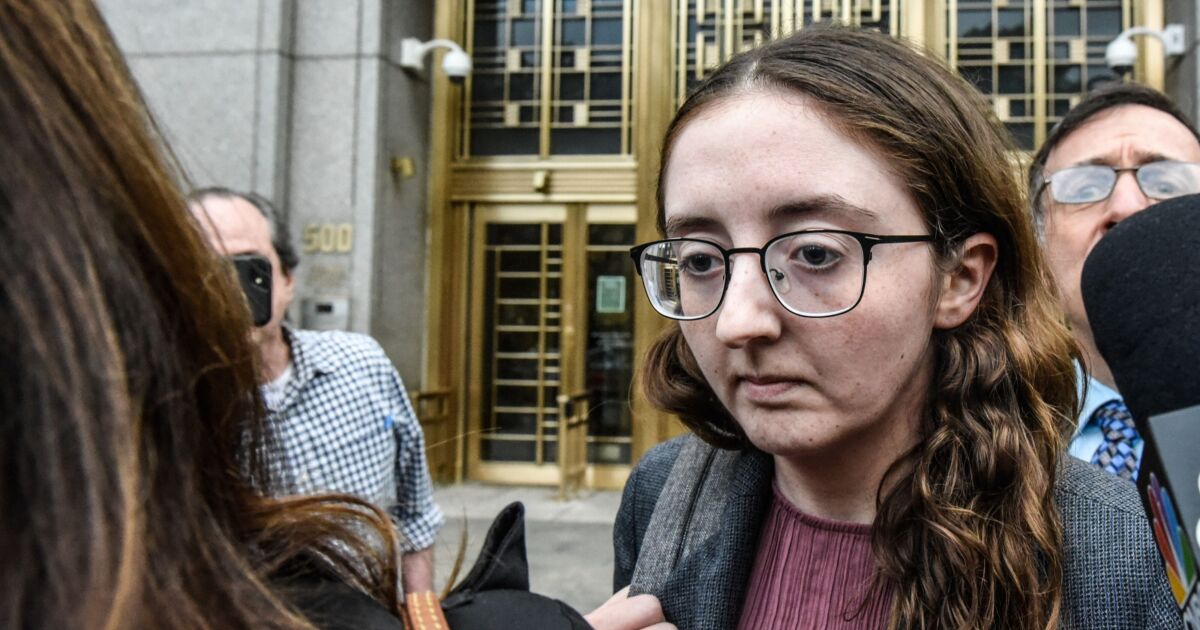Jurors in the fraud trial of FTX co-founder Sam Bankman-Fried heard his ex-girlfriend Caroline Ellison explain how he allegedly arranged for billions of dollars in customer funds to back risky investments that led to the collapse of the cryptocurrency exchange.
Ellison, a math whiz who Bankman-Fried hired and eventually promoted to chief executive officer of Alameda Research, FTX’s sister trading firm, was the latest star witness and close associate to testify against him since the trial began last week. Ellison, who has pleaded guilty and is cooperating with prosecutors, blamed him for orchestrating the fraud and said she continually warned him that his moves could bankrupt FTX and Alameda.
“I thought that Alameda’s financial position was risky, and if the market went down we would lose a lot of money,” Ellison testified. “I was concerned about conveying that information to lenders and worrying about Alameda’s financial health and recalling their loans.”

Stephanie Keith/Bloomberg
Here are some of the most important details so far from Ellison, who will resume testifying on Wednesday:
- ‘Commit crimes’: Eager and well-prepared in her testimony, Ellison was adamant that Bankman-Fried was complicit in orchestrating a massive fraud at FTX and Alameda Research. “He directed me to commit these crimes,” she said. Ellison pleaded guilty to seven felony counts in December. Bankman-Fried, meanwhile, has denied all allegations against him.
- ‘Big job’: Ellison said she was appointed co-chief executive officer of Alameda despite her concerns that it was a “big job” and she didn’t have enough experience, but Bankman-Fried told her he thought she was the right person for the role. She made $200,000 a year and received bonuses of $100,000 to $20 million, but said she ran all big decisions about Alameda by Bankman-Fried and generally deferred to him. Like FTX co-founder Gary Wang, who finished his testimony right before her, Ellison claimed that Bankman-Fried was the ultimate decision-maker within the FTX empire. She said he was fully aware that Alameda was taking FTX customer money and had a practically unlimited credit line on the crypto exchange. Despite publicly distancing himself from Alameda and claiming he did not manage the firm, Ellison said Bankman-Fried directed her on how to handle Alameda’s FTT token holdings and its venture investing, as well as other important business decisions.
- Credit line: She said there were already problems at Alameda when she joined the firm — it had suffered large losses, lenders had pulled money and more than half of the employees quit. Ellison said she wasn’t aware of them until she joined. She said she warned Bankman-Fried on numerous occasions that she was concerned about the way the company was being operated, but that she was regularly reassured by him. At Bankman-Fried’s direction, Alameda began borrowing from third-party crypto funds as well as customer money from FTX, and he’d set up a system for Alameda to borrow from FTX, Ellison testified. She said she was concerned to learn about Alameda’s credit line on FTX, which allowed it to withdraw any amount of capital from the platform, even though no other customer had a credit line worth more than $1 billion. When she asked SBF in 2020 whether this line of credit would show up in FTX’s audit, he said, “don’t worry, the auditors aren’t going to look at that,” she testified.
- Appetite for risk: Ellison reviewed in court some of the documents she prepared while leading Alameda about the potential danger of outstanding loans from crypto lender Genesis and a potential market downturn in digital assets. She said Bankman-Fried frequently dismissed her concerns and had her adjust calculations to make these scenarios more palatable. She said he wanted to move ahead with a $3 billion venture investment despite the major risks it posed to Alameda. She also provided insight into the more than $600 million stake Bankman-Fried acquired in Robinhood in May 2022. Ellison said the stake was paid for by Alameda, but when it came time to disclose the purchase, Bankman-Fried asked to have the equity moved to a different FTX entity because he didn’t want to be publicly associated with Alameda. The acquisition again showed Bankman-Fried’s continued involvement with Alameda, despite his claims that he had little involvement with the firm.
- Raise more money: Ellison said Bankman-Fried was often looking for ways to raise more money. She said he created FTT, the crypto token native to FTX, with FTX’s business development team to generate funds the way rival crypto exchange Binance had with its own BNB token. Seed investors in FTT bought the token for a mere 10 cents, but its price went up to $1 when it was listed on FTX, eventually rising to $50. Alameda received 60% to 70% of the tokens prior to it being listed publicly, according to Ellison. She said Bankman-Fried directed her to put Alameda’s FTT holdings on its balance sheet to get more loans from third-party lenders. He also advised her on when to buy and sell, showing that he still had heavy involvement in Alameda’s decision-making. Ellison said he didn’t want others to know how much say he had in Alameda’s FTT management. Bankman-Fried “at one point got upset at me when I discussed our FTT trading too openly” around other employees, she said.
- Big loans: Genesis, the now bankrupt crypto lender under Barry Silbert’s Digital Currency Group, was a main concern of Bankman-Fried and Ellison as they carried out risk analysis for Alameda. After Alameda struggled to borrow funds in its early years, Bankman-Fried was “very excited” about being able to borrow from Genesis, Ellison said. Alameda’s borrowings from Genesis were mostly collateralized by FTT, she said. In their risk analysis, Ellison took into consideration the probability Genesis would tighten its lending requirements, and how that would impact Alameda’s financial health. She concluded that if Alameda decided to make an additional $3 billion investment and if there was a market downturn that caused the loans to get called by Genesis, there was no way Alameda could repay the loans. In response to her conclusion, Bankman-Fried directed Ellison to try to convert Alameda’s loans with Genesis to term loans from open-term loans to reduce duration risks. Ellison said she was only able to convert some of the Genesis loans. Genesis’s former head of trading and lending, Matt Ballensweig, is on the list of potential witnesses in the trial.
- Dating the boss: Ellison described how the pair met while working at Jane Street Group. Ellison said after Bankman-Fried co-founded Alameda and offered her a job, she quit Jane Street and joined him as a trader in March 2018. Ellison said they began sleeping together in the fall of 2018, dating in the summer of 2020 and ended the relationship in the spring of 2022. “The whole time we were dating, he was also my boss at work, which created some awkward situations,” because he could fire her at any time, Ellison said. She added that Bankman-Fried often seemed disengaged and didn’t pay her enough attention, which contributed to the relationship ending.
- Binance: The world’s biggest crypto exchange by trading volume was a recurring feature in Ellison’s testimony. The prosecution even presented a photo of Bankman-Fried shaking hands with his former rival, Binance CEO Changpeng “CZ” Zhao, as evidence. Binance made an early investment in FTX, and Ellison said it was very important to Bankman-Fried to buy back the $2 billion stake from the crypto exchange. Ellison said she was concerned about the purchase and told Bankman-Fried, “We don’t really have the money for this,” but he moved forward and bought back the equity in 2021. Ellison said that under his direction, Alameda used about $1 billion from its FTX credit line to complete the transaction. Binance received FTT as part of the deal.




